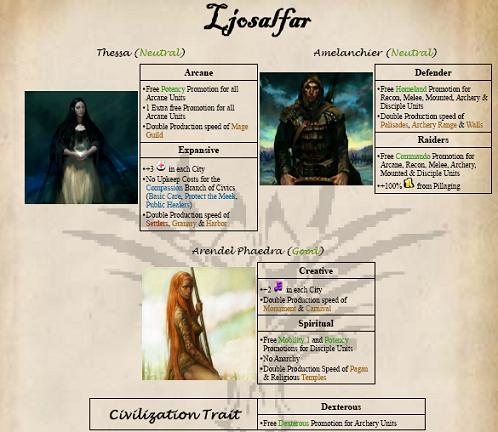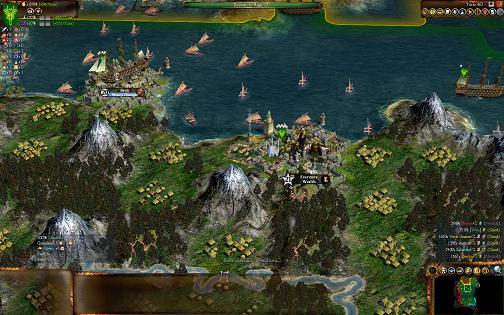
Far from it for me to call myself any sort of expert on Fall from Heaven 2, but I thought there might be some interest in some simple guides for playing each of the factions in the game. They’ll include both stuff from my individual playing experiences and advice that I’ve read elsewhere on the net, most notably from the Civfanatics forums. I don’t know if I’ll ever actually complete playthroughs for each of the factions, but I’ll keep it up for as long as it holds my interest.
This first guide covers the Ljosalfar, generally the good, or at least neutral, elves of Erebus. As the screenshot above shows, they have a choice of three leaders, so let’s start the guide with a discussion of the pros and cons of each of them:
Thessa (Arcane / Expansive)
Arcane is as always a very useful trait to have due to how powerful magic can be in FFH2 but for the elves is particularly important in order to get mages capable of casting fireball as soon as possible. Since the elves cannot build siege engines, you’ll need to rely fireballs to whittle down your enemies’ huge stacks of troops. Expansive is a weaker trait and particularly useless to the elves who have chosen to go the Fellowship of Leaves – Guardian of Nature route since that combo will usually provide more than enough health for your cities. Still, it can be useful to get newly conquered cities up to speed quickly when they don’t have lots of forests around them. All this makes Thessa the best choice if you insist on playing an offensive strategy as the Ljosalfar.
Amelanchier (Defender / Raiders)
Unlike stock Civilization 4, the Defender trait can actually be quite powerful, especially when you consider the fact that your lands will probably be covered by forests and that all of your units are elves. Being able to build Archery Ranges quicker just makes it even easier to pump out your defensive archer troops. Combined with the Raider trait and concentrating on fast moving recon units only, you can easily wage a guerilla war against an enemy, moving quickly through his lands to pillage them and then moving back to the safety of your own forests when he brings up his powerful defending troops. You won’t be very good at actually capturing cities, but you can stall their development while relying on the money from pillaging their improvements to fund your own economy.
Arendel Phaedra (Creative / Spiritual)
Probably the best leader to pursue a builder strategy as the Creative trait makes it possible to aggressively spread your borders without actually having to go to war. Being Spiritual helps this as well since temples also spread culture but the main benefit is being able to switch civics quickly and often without penalty, depending on whether you’re at war or at peace. Note that since your Fellowship of Leaves priests can only cast the Bloom spell within your own cultural borders, playing this leader means that you’ll be able to cover a bigger slice of the map with forests more quickly, stacking the odds in your favor when you do need to fight.
General Strategy
As previously mentioned, since the elves lack siege engines and fight best on forests, they are generally considered a defensive faction. Your best strategy is probably to get Fellowship of Leaves as soon as possible and get a good stock of Priests of Leaves to travel all around your lands to cast Bloom. Remember that not only can you build all of your improvements directly on top of forest tiles without having to cut them down, but having FoL as you state religion will slowly make all of your forests into Ancient Forests, making them more valuable.
Running the Guardian of Nature civic is almost guaranteed to provide your cities with plenty of health and happiness but does slow down your military production. Once you’ve established a solid economy, you can think about adopting other religions depending on your intended strategy. For example, one nasty trick is to temporarily adopt the Ashen Veil religion and raise the Armageddon Counter to 40 and then switch back to FoL. This creates blight in the world but since you have FoL and plenty of forests, you should be protected from the worst effects of it. Do keep in mind that switching religions makes any religious heroes that you’ve built disappear. Eventually elven nations should be completely covered with forests and cottages on flat land and mines on hills. This does make you more vulnerable to pillaging raiders, so be certain to station fast moving quick reaction units at strategic points to defend your lands.
As for your military, elven archers have an inherent bonus so it’s natural to shoot for that, especially if your main concern is defense. It’s also worth noting that your elven unique hero, Gilden Silveric, isn’t the best there is, but has the advantage of being one of the earliest heroes that can come out, which makes it feasible to use him, with suitable supporting troops, to take one or two cities from an enemy early. If you went for FoL early to the detriment of researching the metal line, it’s possible to use Fawns as a stop-gap, but you’ll need to make sure to nurture them carefully to get them to level 6 so that they can be upgraded to Satyrs. Once more powerful units become the norm, the Fawns become more or less useless as there’s almost nothing that they can kill and get XP off of. If you can, try to build the Pact of the Nilhorn wonder. These giants can bombard enemy cities and will be invaluable to the elves, on top of being a more than decent melee unit at the stage that they’re built.
One good rule of thumb in FFH2 is that you need to rush to a final tier unit as soon as possible because if an enemy gets there before you and starts attacking you with it, there’s little that you can do against it. The temptation for the Ljosalfar is to go for the Flurry, but my personal preference is to go for the Beastmaster first, particularly since you should already have invested research along that line for FoL. You will need to build and upgrade mages as well, of course, and getting fire mana will be a priority in order to be able to cast the all important fireballs. The other type of mana you should prioritize is water mana, in order to put out fires. Since your entire strategy depends so heavily on forests, having them razed is definitely going to ruin your day.
Finally the Ljosalfar worldspell, March of the Trees, is highly situational, so don’t think that you absolutely need to use it. It turns all forests and ancient forests within your cultural borders into a Treant that lasts for 5 turns. This sounds powerful but the problem is that losing all those forests will probably crash your economy and plunge your cities into unhealthiness and unhappiness. One option is to use it early to take out enemy cities near your borders before your cities become too reliant on the forests. Apart from that, you’ll probably have to keep it in reserve for use only when you’re being invaded and so badly outnumbered that it’s either use this spell or get killed.
There are too many end-game possibilities so I won’t go into them, but the above should be enough to get your nation well established enough to try for any strategy you’d want. The Ljosalfar is generally a late-game boomer faction. As long as you can survive the early stages of the game and carve out a decent slice of the world to cover in forests, you should be well placed to dominate the late game. Good luck!

One thought on “A Quick Guide to the Ljosalfar”